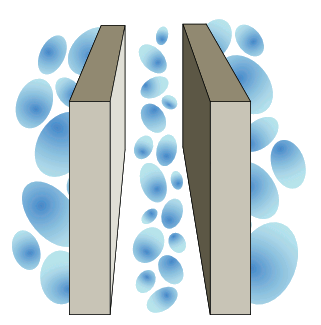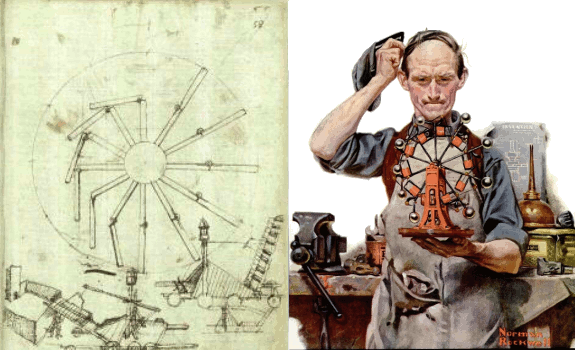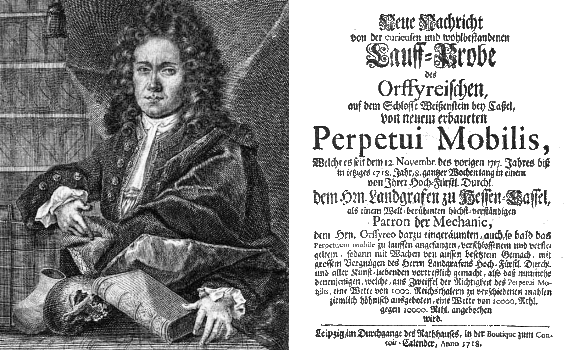Perpetual Motion
May 17, 2013
Novel
energy sources are always welcome, especially those that don't cause
carbon emission or other
environmental consequences. One interesting
fictional energy source that seems to satisfy these conditions is the
Zero Point Module (ZPM) of the various
Stargate television series. As are most
science fiction devices, the Zero Point Modules are associated with an established scientific principle that offers credibility. In this case, it's the
zero-point energy of the
vacuum.
Zero-point energy is the
ground state energy, the lowest energy state, of a
quantum mechanical system. This energy is not zero, so everything in our
universe sits atop a baseline energy reservoir. Perhaps I shouldn't use the term, "reservoir," since it doesn't appear possible to tap into this energy, ZPMs notwithstanding, although the
Casimir effect might cause you to think otherwise.
The Casimir Effect is named after
Dutch physicist,
Hendrik Casimir. In 1948, Casimir predicted that
conductors spaced less than a
micrometer apart will attract each other in a perfect vacuum, since the region between the conductors form an
electromagnetic resonator that will only support a subset of the
frequency modes of the vacuum state, the zero-point state. The vacuum outside this region, which supports all modes, will exert a
pressure on the conductors.

Illustration of the Casimir effect.
The vacuum region outside parallel conducting plates supports all modes, whereas the number of modes allowed between the plates is restricted. There is a net exterior pressure that acts to push the plates together.
(Via Wikimedia Commons))
Ten years after his prediction, Casimir's effect was roughly demonstrated by one of Casimir's colleagues at the
Philips Research Laboratories, and an
experiment in 1997 demonstrated the Casimir Effect to 95%
accuracy.[1]
Atomic force microscopy experiments, for which separations can be very small, has brought the agreement to 99%. The Casimir effect has implications for
MEMS devices, since it's been shown to change the resonance frequency of a
MEMS oscillator.[2] A review article about the Casimir effect is available on
arXiv.[3]
It's no wonder that the Casimir effect has people dreaming about free energy (free, as in
beer, not
this free energy). If it were possible to achieve a separation of just ten
nanometers for
square centimeter parallel plate conductors, the attractive force from the Casimir effect would be 10
newtons, or
one kilogram of force! The problem, however, is how to convert that force to useful
work, since separating the plates requires the same force, and you would need to do that in a work cycle in any machine. Some schemes for separating the plates make the analysis a little complicated, but careful calculations will give the same prognosis.
This brings us to our topic of
perpetual motion machines, which has a long history. I wrote about such machines in a
previous article (Second Law of Thermodynamics, February 7, 2011). Although
inventors have been fascinated by the idea of perpetual motion for hundreds of years, perpetual motion is disallowed by the
first and
second law of thermodynamics.
The first law of thermodynamics is the
conservation of energy law. The second law essentially says that thermal systems will equilibrate after sufficient time and natural processes are
irreversible.
Physicists have been developing and validating
thermodynamics for hundreds of years, so they're naturally skeptical about perpetual motion. The
American Physical Society issued the following
statement in 2003:
"The American Physical Society deplores attempts to mislead and defraud the public based on claims of perpetual motion machines or sources of unlimited useful energy, unsubstantiated by experimentally tested established physical principles."
The
US Patent and Trademark Office does not grant
patents for perpetual motion machines, as explained in its
Manual of Patent Examining Procedure (MPEP).
"A rejection on the ground of lack of utility is appropriate when (1) it is not apparent why the invention is “useful” because applicant has failed to identify any specific and substantial utility and there is no well established utility, or (2) an assertion of specific and substantial utility for the invention is not credible. Such a rejection can include the more specific grounds of inoperativeness, such as inventions involving perpetual motion."(Section 706.03a)

The overbalanced wheel is a popular object in perpetual motion lore. The idea, which dates back to the Indian astronomer, Bhaskara II, in the twelfth century, is that the extended pendula on one side should exert a greater driving force to push the wheel around. What's not realized is that there is more mass on the opposite side of the wheel, so the forces equilibrate. Source images, left, a fifteenth century drawing by Taccola, and right, a Norman Rockwell illustration from the October, 1920, issue of Popular Science, via Wikimedia Commons)
The Casimir effect is not the only microscopic machine that at first appears to give a perpetual motion, but in fact will not.
Richard Feynman invented the
Brownian ratchet, a
ratchet that moves just one direction when excited by
randomly moving
molecules. The ratchet in his thought experiment seems as if it should extract work from
thermal fluctuations, but a detailed analysis shows that it will work only as long as the ratchet is cooler than its environment.
An arXiv article, posted earlier this year by
Alejandro Jenkins of
Florida State University, reviews the life of perpetual motion
entrepreneur,
Johann Bessler, also known as Councillor Orffyreus, who flourished
about three hundred years ago.[4] According to Bessler's Wikipedia page, his latinized pseudonym, Orffyreus, was devised by his doing a
ROT13 transform of his name.
This was a time before
Sadi Carnot,
Count Rumford,
Rudolf Clausius,
Lord Kelvin and
Constantin Carathéodory, so thermodynamics had not been developed. That's why it's probably not surprising that
Gottfried Leibniz and
Johann Bernoulli thought Bessler's perpetual motion machine, called "Bessler's Wheel," to be real.[4]
Bessler became intrigued by perpetual motion after a visit to a
monastery at which he saw a
rotisserie that appeared to turn on its own.[4] I speculate that the inventive
monks may have used something like
Hero's engine. After a fortunate
marriage boosted his social and financial standing, Bessler built a series of huge perpetual motion wheels. Although these were fabricated to appear to operate as overbalanced wheels, the works were always hidden, with Bessler asking for a huge reward to reveal the miraculous mechanism.[4]

Bessler and the title page of one of his pamphlets. A human skull always adds an air of authenticity. (Source images, left and right, via Wikimedia Commons.)
Bessler published
pamphlets, such as in the above figure, advertising his perpetual motion wheel, but there were skeptics who counterbalanced the opinions of the believers I mentioned earlier. Finally, Bessler's
maid revealed that the wheels had always been turned from an adjacent room, and that she had sometimes done the turning.[4]
Although some questioned the statements of a
house servant, Bessler's wife also told of the deception. As interest in his wheel declined, Bessler concocted other miraculous inventions in his later years, until he died in a fall in 1745 while constructing a
windmill in
Fürstenberg.[4]
Jenkins finishes his article with his observation on why men of intellect in Bessler's time could have believed his claims.
Scientists are not trained to spot deliberate deceptions, as our culture is one of open and honest discourse.[4] Many lessons can be learned from the
Schön scandal.
References:
- S. K. Lamoreaux, "Demonstration of the Casimir Force in the 0.6 to 6 μm Range," Phys. Rev. Lett. vol. 78, no. 1 (January 6, 1997), pp. 5-8.
- H. B. Chan, V. A. Aksyuk, R. N. Kleiman, D. J. Bishop, and Federico Capasso, "Nonlinear Micromechanical Casimir Oscillator," Phys. Rev. Lett., vol. 87, no. 21 (November 19, 2001), 211801.
- M. Bordag, U. Mohideen, V.M. Mostepanenko, "New Developments in the Casimir Effect," arXiv Preprint Server, June 8, 2001.
- Alejandro Jenkins, "The Mechanical Career of Councillor Orffyreus, Confidence Man," arXiv Preprint Server, January 14, 2013. Also appears as Alejandro Jenkins, "The mechanical career of Councillor Orffyreus, confidence man," American Journal of Physics, vol. 81, no. 6 (June, 2013), pp. 421-427.
- Perpetual Motion Page on Wikipedia.
- History of Perpetual Motion Page on Wikipedia.
Permanent Link to this article
Linked Keywords: Energy sources; greenhouse gas; carbon emission; unintended consequences; environmental consequences; fiction; Zero Point Module; Stargate; television series; science fiction; zero-point energy; vacuum state; vacuum; ground state; quantum mechanics; quantum mechanical system; universe; Casimir effect; Dutch; physicist; Hendrik Casimir; conductor; micrometer; electromagnetism; electromagnetic; resonator; frequency mode; pressure; Wikimedia Commons; Philips Natuurkundig Laboratorium; Philips Research Laboratories; experiment; accuracy and precision; atomic force microscopy; microelectromechanical systems; MEMS; microelectromechanical system oscillator; MEMS oscillator; arXiv; beer; thermodynamic free energy; nanometer; square centimeter; parallel; newton; kilogram-force; work; perpetual motion; inventor; first law of thermodynamics; second law of thermodynamics; conservation of energy; irreversible process; thermodynamics; American Physical Society; US Patent and Trademark Office; patent; Manual of Patent Examining Procedure (MPEP); section 706.03a; India; astronomer; Bhaskara II; twelfth century; pendulum; pendula; mass; mechanical equilibrium; overbalanced wheel; Taccola; Norman Rockwell; Popular Science; Richard Feynman; Brownian ratchet; ratchet; randomness; random; molecule; thermal fluctuation; Alejandro Jenkins; Florida State University; entrepreneur; Johann Bessler; 18th century; ROT13; Sadi Carnot; Benjamin Thompson; Count Rumford; Rudolf Clausius; William Thomson; Lord Kelvin; Constantin Carathéodory; Gottfried Wilhelm Leibniz; Gottfried Leibniz; Johann Bernoulli; monastery; rotisserie; monk; Hero's engine; marriage; pamphlet; human skull; maid; house servant; windmill; Fürstenberg; scientist; Schön scandal.